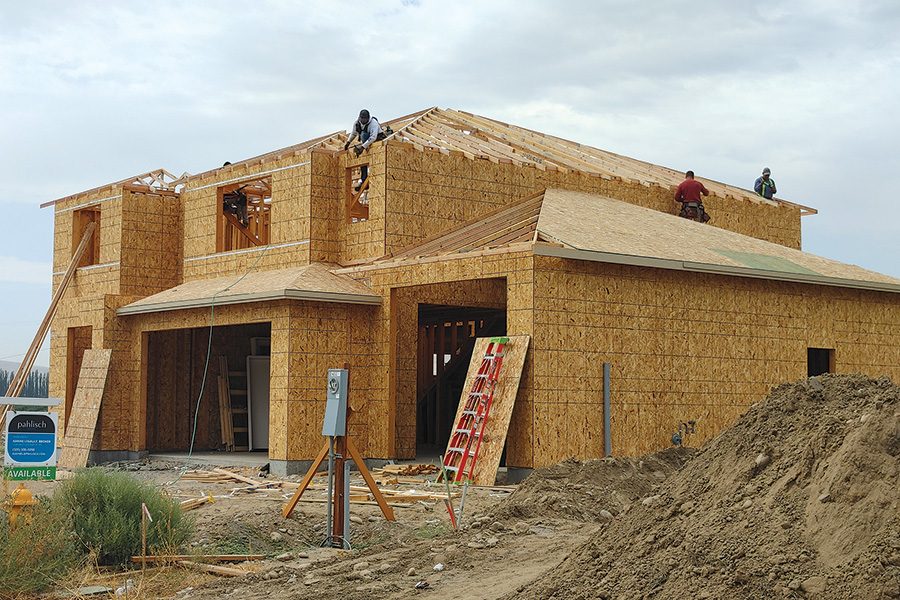
Home » Homebuilding slows in the Tri-Cities but demand goes on
Homebuilding slows in the Tri-Cities but demand goes on

August 11, 2022
Four interest rate hikes and a supply chain that adds months to the delivery for everything involved with homebuilding is curtailing new home construction in the Tri-Cities.
Local homebuilders secured permits for 768 homes in the first seven months of 2022, according to HBA research. That is down from the 1,055 issued in the same period in 2021 and from the six-year average of 908, or a drop of 27% compared to last year and 15% behind the recent average.
The precipitous drop in new home starts is not solely the result of macro conditions, according to Jeff Losey, executive director of Home Builders Association of the Tri-Cities.
“For starters, it’s good to recognize that traditionally in the summer, that’s not the peak for new construction sales,” said Losey, explaining that families time new home purchases to the start of the school year, which begins around Labor Day in the Tri-Cities. That means signing contracts months earlier.
“There’s usually a slowdown in new construction in June to August,” Losey said.
The slowdown in new construction isn’t slowing the larger residential market for now.
The inventory of homes for sale – new and old – is rising. It hasn’t reached the 1,200 the market warrants, but stood at 640 in early August, more than in the past years.
For buyers, that means more choice. For sellers, there are fewer bidding wars.
The Tri-City Association of Realtors reported 498 home sales in June – the most recent figures available – and an average sale price of $480,000. There were 470 home sales a year prior, at an average price of $418,000.
Dave Retter of Retter & Co. Sotheby’s international Realty in Kennewick welcomes an increase in inventory and isn’t fretting about construction. More homes inject balance in the market and let buyers take time to choose the right one.
People should love their homes, he said.
And he’s comfortable builders will keep working, though perhaps at a slower pace.
“The builders are going to continue to build. It’s hard to be a builder now with the pricing and supply chain,” he added.
Losey said land availability is working against new construction. That helps explain why some cities have seen consistent building and others recorded drops.
Kennewick and Richland saw modest dips in permit activity, while Pasco and West Richland saw significant ones. Manufactured home permits fell too.
- Kennewick reported 137 single-family homes through July 2022 compared to 143 in 2021.
- Richland reported 211 compared to 236.
- Pasco reported 154 compared to 263.
- West Richland reported 80 compared to 187.
- There were 45 permits for manufactured homes compared to 51 for the region.
Losey said it takes time to create a buildable lot, meaning a site with streets and infrastructure such as water, sewer, cable and so forth.
Pasco, with the biggest drop, is finalizing its Urban Growth Area, which will bring in more land, he said.
“Once all that buildable land is platted and lots are ready to go, there’s always a bit of a lag in trying to catch up. It was expected we should slow down,” he said.
The longer term impact of a decline in construction is harder to predict.
The Tri-Cities has long been short of homes, whether new or existing.
Even if lots become available, rising interest rates make home-buying a bigger challenge. The Federal Reserve is expected to continue raising the prime interest rate to curb inflation, but recent jobs news raises questions about whether it is needed. Locally, the Mid-Columbia workforce stood at 158,000 in June, nearly 5,000 more than in 2019, before the pandemic.
“So, we don’t know what it will look like over the next few quarters. We’ll need that before we can measure what 2023 is going to look like,” Losey said.
He predicts cooling prices, fewer bidding wars and less urgency to build.
“You don’t want to get too far out over your skis,” he advised.
Retter used a similar ski analogy. The developers his company represents aren’t going to put themselves at risk by overbuilding.
He noted that the interest rate hikes occurred in a relatively short period. The last time that happened was the early 1980s.
“So yes, we’re absorbing it. I don’t see that as the sky falling.”
Kerwin Jensen, Richland’s director of community development services, confirmed new home construction is tracking only slightly behind 2021 levels. But he noted that economic development continues to drive job growth in the Tri-Cities and that translates into a continuing need for new homes and apartments.
Jensen said buyers will adapt to rising interest rates. He paid what would seem like an unusually high interest rate to purchase his first home early in his career. People adapt and do what they have to, he said.
“Life goes on. Even if there is a higher interest rate, there is a need for housing.”
Real Estate & Construction Local News
KEYWORDS august 2022





